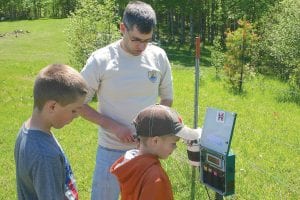Oscar and Ty Mielke watched as U.S. Fish & Wildlife Biologist Kevin Heist changed the batteries on an ultrasonic device last Tuesday. The ultrasonic detector is used to pick up the sounds of bats and birds as they migrate. The Mielke brothers and cousin Reuben Youngdahl were at their grandparent’s farm the day the biologists came to do maintenance on Merlin, the avian radar system, and the gear associated with it.

Oscar Mielke, age 10, was pointing to the multi-colored squiggly lines on the computer screen, asking questions.
Bursting with energy, his brother Ty, age 7, couldn’t make up his mind if he wanted to be in or out of the small trailer on such a nice day, but he too, at times was intensely interested in the data flashing across the two computers.
Meanwhile, first cousin Reuben Youngdahl, age 11, waited quietly to pose queries of his own as Nathan Rathburn, a biologist who works for the U.S. Fish & Wildlife Service, patiently explained the bird and bat migration patterns to Dave and Cathi Williams’ grandchildren.
Tuesday, June 5, was a great day to be a kid on the Williams’ farm.
For now, Merlin will stay put, said Rathburn,
Merlin is the name given to a large mobile avian radar system that was placed in the lower half of Dave and Cathy Williams’ farm on May 8.
The plan was to leave it there for about a month and gather data on bird and bat migration as the winged aviators fly across Lake Superior or around the lake, but due to the cold spring, Rathburn said Merlin would stay for at least two more weeks.
The Williams’ farm is located about a half mile above Lake Superior and is home to many songbirds and visiting geese.
Rathburn and fellow biologist Kevin Heist were at the farm on Tuesday to do maintenance on Merlin and change batteries in the ultrasonic units placed around the edges of the farm.
The ultrasonic devices pick up the songs of birds and ultrasonic sounds of bats. Each bird and bat makes distinctive sounds that can be distinguished between species.
In addition to radar, Merlin is also equipped with a weather station.
Merlin is equipped with horizontal radar that extends two miles on each side of the unit. It also has a vertical detector that picks up movement three-quarters of a mile on each side of the mobile lab.
The computers, one with the vertical information and one with the horizontal data, give 15-minute pictures of the migration. The unit operates 24 hours of the day, seven days a week.
Peak bird and bat movement are typically from 11:45 p.m. to midnight. As shown on the screens, the migration of birds, most of which are songbirds, really picks up at dusk and slows to a crawl when the sun comes up.
When asked why songbirds typically fly at night, Rathburn said, “No one knows for sure, but there are some good theories. One is that it is cooler at night and birds expend less energy to fly. Another suggests that because the predators aren’t out at night, it’s safer. Winds are also more stable at night, so it’s easier for the birds to gauge their flights. Those are just some of the theories, but it might be a combination of all of them or other reasons we don’t know.”
It was surprising to learn that songbirds fly, on average, about 1,000 to 2,000 feet in the air as they come across the lake. Some fly as high as 8,000 feet, and probably higher, said Rathburn, but that’s the cut-off ceiling for the radar. Rathburn noted pilots flying jets have seen geese at extremely high altitudes.
Songbirds— sparrows, thrushes, robins, wrens, etc.— tend to fly about 20 miles per hour, so a flight from Ashland to Grand Marais, depending upon the direction of the wind, takes 3½ to 4 hours.
One of the things the two biologists noticed over the last month is that there has been some reverse migration going on. Birds fly across the lake, stay briefly and then fly back across the lake.
“We don’t often see this,” said Rathburn. “But it might have something to do with the cold spring.”
“Could be a lack of bugs or other types of food are in short supply,” said Heist.
The puzzling swings in migration are one reason Merlin will stay put for a while. Maybe, too, because of the cold spring, the full movement hasn’t occurred yet, and this extended visit will catch it when it happens, noted Rathburn.
The data, when “scrubbed” of clutter (storms or bug swarms), collected from Merlin will be combined with current and historical bird surveys, banding data, weather data, NEXRAD radar, and information obtained from acoustic and ultrasonic monitors to give the U.S.F.W.S. a much clearer picture of bird and bat migration.
Information gathered in this extensive study that began in 2011 from the entire Great Lakes region will be used to formulate guidelines used to show where and when wind turbines can operate with minimum risk of harming migrating birds and bats.
As the need for renewable energy increases, the demand for energy produced in an environmentally friendly way will be more in demand, Rathburn said.
This project also hopes to show areas around the Great Lakes that have high concentrations of migrant bird and bat populations. This may include stopover habitat where birds and bats eat and rest before continuing migration as well as areas along the lakeshore that concentrate the migrant communities.
“The work is pretty neat,” Rathburn said as Heist nodded his head in agreement. Meanwhile, far off, three boys tailed their grandpa back to the farmhouse, sounds of joyous laughter and boyish banter carrying across the greening field.


Loading Comments